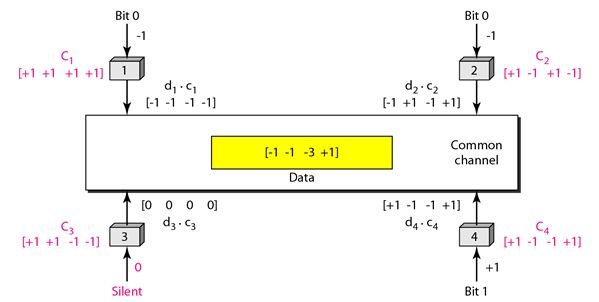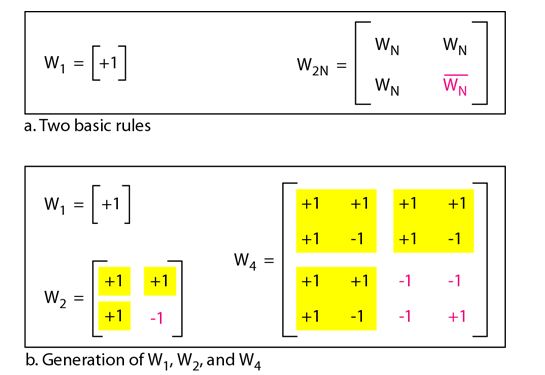Channelization Protocols
Channelization is a multiple-access method in which the available bandwidth of a link is shared in time, frequency, or through code, between different stations. The three channelization protocols are FDMA, TDMA, and CDMA.
The Frequency-Division Multiple Access (FDMA):
In frequency-division multiple access (FDMA), the available bandwidth is divided into frequency bands. Each station is allocated a band to send its data. In other words, each band is reserved for a specific station, and it belongs to the station all the time. Each station also uses a bandpass filter to confine the transmitter frequencies. To prevent station interferences, the allocated bands are separated from one another by small guard bands. The following figure shows the idea of FDMA.
The differences between FDM and FDMA are as follows:
FDM, is a physical layer technique that combines the loads from low-bandwidth channels and transmits them by using a high-bandwidth channel. The channels that are combined are low-pass. The multiplexer modulates the signals, combines them, and creates a bandpass signal. The bandwidth of each channel is shifted by the multiplexer.
Carrier Sense Multiple Access Protocol
FDMA, on the other hand, is an access method in the data link layer. The data link layer in each station tells its physical layer to make a bandpass signal from the data passed to it. The signal must be created in the allocated band. There is no physical multiplexer at the physical layer. The signals created at each station are automatically bandpass-filtered. They are mixed when they are sent to the common channel.
Time-Division Multiple Access (TDMA):
In time-division multiple access (TDMA), the stations share the bandwidth of the channel in time. Each station is allocated a time slot during which it can send data. Each station transmits its data in is assigned time slot. The following figure shows the idea behind TDMA.
The main problem with TDMA lies in achieving synchronization between the different stations. Each station needs to know the beginning of its slot and the location of its slot. This may be difficult because of propagation delays introduced in the system if the stations are spread over a large area. To compensate for the delays, we can insert guard times. Synchronization is normally accomplished by having some synchronization bits at the beginning of each slot.
The differences between TDMA and TDM are :
• TDM is a physical layer technique that combines the data from slower channels and transmits them by using a faster channel. The process uses a physical multiplexer that interleaves data units from each channel.
• TDMA, on the other hand, is an access method in the data link layer. The data link layer in each station tells its physical layer to use the allocated time slot. There is no physical multiplexer at the physical layer.
Code-Division Multiple Access (CDMA):
CDMA simply means communication with different codes. CDMA differs from FDMA because only one channel occupies the entire bandwidth of the link. It differs from TDMA because all stations can send data simultaneously; there is no timesharing.
Implementation:
Let us assume we have four stations 1, 2, 3, and 4 connected to the same channel. The data from station 1 are d1 , from station 2 are d2, and so on. The code assigned to the first station is c1, to the second is c2, and so on. We assume that the assigned codes have two properties.
1. If we multiply each code by another, we get 0.
2. If we multiply each code by itself, we get 4 (the number of stations).
With these two properties in mind, how the above four stations can send data using the same common channel, as shown in the following figure.
Station 1 multiplies (a special kind of multiplication, as we will see) its data by its code to get d1.c1. Station 2 multiplies its data by its code to get d2.c2. And so on. The data that go on the channel are the sum of all these terms, as shown in the box.
Any station that wants to receive data from one of the other three multiplies the data on the channel by the code of the sender. For example, suppose stations 1 and 2 are talking to each other. Station 2 wants to hear what station 1 is saying. It multiplies the data on the channel by c1 the code of station1.
Because (c1.c1) is 4, but (c2 . c1), (c3. c1), and (c4 .c1) are all 0s, station 2 divides the result by 4 to get the data from station1.
data =(d1.c1+d2.c2+d3.c3+d4.c4).c1
= c1. d1. c1+ c1. d2. c2+ c1. d3. c3+ c1. d4. c4= 4d1
Chips:
CDMA is based on coding theory. Each station is assigned a code, which is a sequence of numbers called chips, as shown in the following figure. The codes are for the previous example.
We need to know that we did not choose the sequences randomly; they were carefully selected. They are called orthogonal sequences and have the following properties:
1. Each sequence is made of N elements, where N is the number of stations.
2. If we multiply a sequence by a number, every element in the sequence is multiplied by that element. This is called multiplication of a sequence by a scalar. For example,
2. [+1 +1-1-1] = [+2+2-2-2]
3. If we multiply two equal sequences, element by element, and add the results, we get N, where N is the number of elements in the each sequence. This is called the inner product of two equal sequences. For example,
[+1 +1-1 -1]. [+1 +1 -1 -1] = 1 + 1 + 1 + 1 = 4
4. If we multiply two different sequences, element by element, and add the results, we get 0. This is called inner product of two different sequences. For example,
[+1 +1 -1-1] • [+1 +1 +1 +1] = 1 + 1 - 1 - 1 = 0
5. Adding two sequences means adding the corresponding elements. The result is another sequence. For example,
[+1+1-1-1]+[+1+1+1+1]=[+2+2 +0 +0]
Data Representation:
We follow the following rules for encoding: If a station needs to send a 0 bit, it encodes it as -1, if it needs to send a 1 bit, it encodes it as +1. When a station is idle, it sends no signal, which is interpreted as a 0.
Encoding and Decoding:
As a simple example, we show how four stations share the link during a 1-bit interval. The procedure can easily be repeated for additional intervals. We assume that stations 1 and 2 are sending a 0 bit and channel 4 is sending a 1 bit. Station 3 is silent.
The data at the sender site are translated to -1, -1, 0, and +1. Each station multiplies the corresponding number by its chip (its orthogonal sequence), which is unique for each station. The result is a new sequence which is sent to the channel. For simplicity, we assume that all stations send the resulting sequences at the same time. The sequence on the channel is the sum of all four sequences as defined before. The following figure shows the situation.

Now imagine station 3, which we said is silent, is listening to station 2. Station 3 multiplies the total data on the channel by the code for station 2, which is [+1 -1 +1-1],
to get
[-1-1-3 +1]• [+1-1 +1-1] =-4/4 =-1 ---- --> bit 1
Sequence Generation:
To generate chip sequences, we use a Walsh table, which is a two-dimensional table with an equal number of rows and columns, as shown in the following figure.
In the Walsh table, each row is a sequence of chips. W1 for a one-chip sequence has one row and one column. We can choose –1 or +1 for the chip for this trivial table (we chose +1).
According to Walsh, if we know the table for N sequences WN we can create the table for 2N sequences W2N, as shown in Figure. The WN with the overbar WN stands for the complement of WN where each +1 is changed to -1 and vice versa.
The above figure also shows how we can create W2 and W4 from W1. After we select W1, W2 can be made from four W1 's, with the last one the complement of W1 After W2 is generated, W4 can be made of four W2's, with the last one the complement of W2. Of course, W8 is composed of four W4's, and so on. Note that after WN is made, each station is assigned a chip corresponding to a row.
Something we need to emphasize is that the number of sequences N needs to be a power of 2. In other words, we need to have N = 2m.
For Further Reading:
Carrier Sense Multiple Access with Collision Detection
Carrier Sense Multiple Access with Collision Avoidance
Controlled Access Protocols
Back to DCN Questions and Answers

.JPG)
.JPG)
.JPG)


